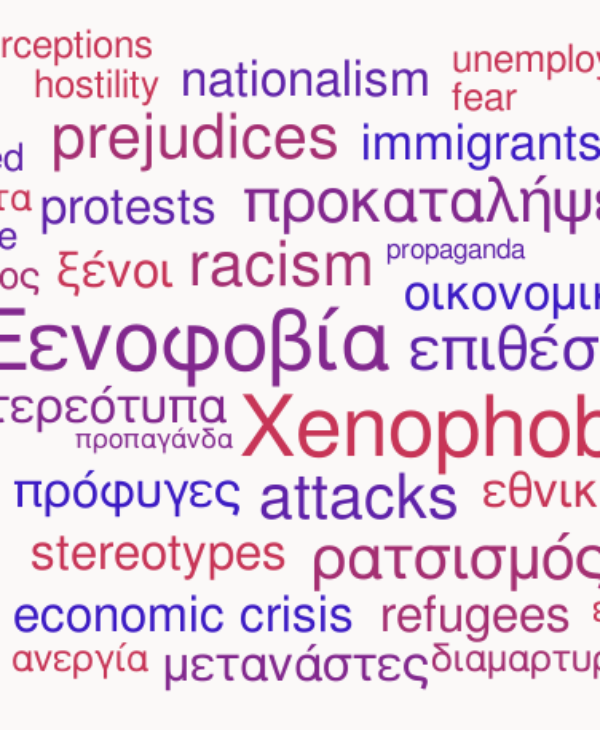Sentiment Analysis
Xenophobia as a “psychological state of hostility or fear towards outsiders” [1] is associated with feelings of dominance (implying superiority) or vulnerability (implying the perception of threat), respectively [2]. As a disposition, xenophobia can be the basis of racism, fascism, and nationalism [3], since it is often rooted in (cultural, religious, racial, etc.) prejudices or driven by ideology. In this context, xenophobia is often examined also as an activity, and in particular as a violent practice [4]. Focusing on the violence aspect of xenophobia, in this project we examine the phenomenon from the perspective of Verbal Aggressiveness (VA) towards specific Target Groups (TGs) of interest (e.g. Pakistani, Muslims, Immigrants in general, Refugees in general). The TGs are defined based on a number of criteria (e.g. population of the specific ethnic groups in Greece, dominant prejudices in Greece about the specific groups). The concept and the content of Verbal Aggressiveness (VA) have been studied within the scope of psychology and communication studies [8, 6, 9] in different contexts (e.g. parental relations). Online VA is often examined with reference to xenophobia and racism [7]. According to the definition of [6] “Verbal Aggression involves using messages to attack other people or those aspects of their lives that are extensions of their identity”. Depending on the approach several typologies of verbal aggressive messages (VAMs) have been proposed (e.g. character attacks, physical appearance attacks, background attacks, teasing, and threats [10, 11], group membership or personal failing attacks [9]). The automatic detection of such attacks can help to measure and monitor xenophobia as a violent practice in Greece over time. We employ a data-driven approach focusing on explicitly stated aggressive messages/expressions towards the TGs of interest. In particular, to build the proposed VA analysis framework we compiled and explored data collections for each TG. Then, based on qualitative data analysis findings and observations we classified VAMs into particular types and designed the resources needed for the computational treatment of the proposed framework.
[1] V. Reynolds, V., and. Vine, I. 1987. The Socio-Biology of Ethnocentrism: Evolutionary Dimensions of Xenophobia, Discrimination, Racism and Nationalism, Croom Helm, London 1987, 28.
[2] van der Veer, K. et al.. 2013. “Psychometrically and qualitatively validating a cross-national cumulative measure of fear-based xenophobia”, Quality & Quantity 47.3 (2013): 1429-1444.
[3] Delanty, G., and O’Mahony,P. 2002. Nationalism and Social Theory, Sage, London 2002, 163.
[4] Bronwyn, H.. 2002. “A new pathology for a new South Africa?”, in D. Hook and G. Eagle, (eds) Psychopathology and Social Prejudice, Cape Town: University of Cape Town Press, 2002, 169-184.
[5] Berkowitz, L. 1993. Aggression: Its causes, consequences, and control. New York, NY: McGraw-Hill.
[6] Hamilton, M., and Hample, D.. 2011. “Testing Hierarchical Models of Argumentativeness and Verbal Aggressiveness”, Communication Methods and Measures, 2011, 5(3), 250-273.
[7] Laineste, L. 2012. “Verbal expressions of aggressiveness in Estonian Internet”, Estonia and Poland. Creativity and tradition in cultural communication, 2012, 1: 205-220.
[8] Infante, D., and Wigley, C. 1986. III, “Verbal aggressiveness: An interpersonal model and measure”, Communication Monographs, 1986, 53:1, 61-69 (61)
[9] Terry Kinney, T. 1994. “An inductively derived typology of verbal aggression and its association to distress”, Human Communication Research, 1994, 21:2, 183-222.
[10] Infante, D. 1987. “Aggressiveness”, in J.C. McCroskey and J.A. Daly (eds.), Personality and interpersonal communication, Sage, Newbury Park 1987, 158.
[11] Infante, D.A., Sabourin, T.C., Rudd, J.E., & Shannon, E. A. (1990). "Verbal Aggression in Violent and Nonviolent Marital Disputes." Communication Quarterly, 38(4), p361-371

